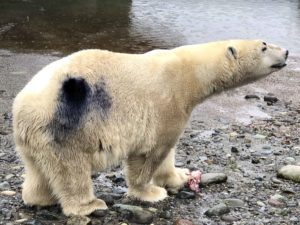
Glue? Tape? Dye? It’s all part of our mission to help protect polar bears in the wild, with a new scientific study that Zoo guests may soon watch in action.
Point Defiance Zoo & Aquarium, with its beloved polar bear Blizzard, has worked for years with the non-profit Polar Bears International (PBI) to tell the story of polar bears in the wild, and the challenges they face from climate change.
The Zoo is a PBI Arctic Ambassador Center, and keepers and other staff have traveled to see bears in Churchill, Manitoba – most recently staff biologist Cindy Roberts.
Now, the two organizations are also partnering in scientific research on zoo bears that will make it easier to study – and hopefully save – their counterparts in the wild.
“Through The Zoo Society’s Dr. Holly Reed Conservation Fund, we’re able to support research projects that use our polar bear here as a model for wild bears,” explains Zoo general curator Dr. Karen Goodrowe. “We have so much to learn.”
Collars, hair dye, stickers

First, the fund helped PBI fit GPS ear tag
trackers onto wild polar bears as they wandered past Churchill every fall to hunt on newly-forming Hudson Bay sea ice nearby. The ear tags supply crucial data about bear migration as those sea ice levels shrink with global warming from climate change.
Then came a University of Washington study on polar bear hair growth. After months of training, keepers were able to apply a patch of black dye to Blizzard’s side, gently plucking a few hairs both then and later to measure growth. This baseline data – so difficult to get from wild polar bears – is invaluable for studying stress levels, contaminant exposure and nutritional needs. The study is still continuing.
Soon, the Zoo will support a PBI study on another innovative way to attach GPS trackers: literally sticking them on.
“There is an increasing need for reliable devices to become smaller, with less invasive attachment methods,” say lead scientists Drs. Geoff York and B.J. Kirschhoffer in the study’s proposal.
The pair have been working with adhesive company 3M on different types of glue, tape or Velcro-like “burrs,” testing each in conditions that mimic the cold, wet and rough world of a wild polar bear.
But in the end, they’ll need to be tested on real bears – and that’s where Blizzard comes in.
Our bears help science
“Our staff are excellent at training, and this offers our bear a lot of enrichment mentally and physically,” Goodrowe says.
When the study begins, Zoo guests may spot a new GPS tag prototype somewhere on Blizzard’s fur. The most successful attachment technique could revolutionize the way wild bears are tracked and studied.
The collaboration, however, goes way beyond Blizzard. Point Defiance Zoo is one of 25 North American zoos in the Association of Zoos & Aquariums’ polar bear Species Survival Plan®. Over half are involved in some kind of research, pooling knowledge with the scientific community to better protect wild polar bears.
“Zoos often lead and contribute to key research studies that would be impossible to conduct with wild polar bears,” says Alysa McCall, director of conservation outreach at PBI. “They help further our knowledge and support our outreach around polar bears, climate change, and solutions. Point Defiance Zoo is one of these key contributors.”
Save our Sea Ice
And of course, everyone else can do their part to help polar bears by reducing their climate footprint – lowering energy use, driving less and not idling their car – plus speaking up to get companies, cities and industries away from fossil fuels and into clean energies.
“Polar bear populations are dwindling, but the more we learn, the more we can help them,” Goodrowe sums up. “It’s vital that we all work together.”